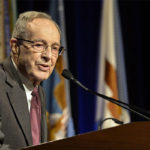by Michael Krepon | July 20, 2020
Quote of the week:
“We have usurped many of the powers we once ascribed to God. Fearful and unprepared, we have assumed lordship over the life or death of the whole world – of all living things. The danger and the glory and the choice rest finally in man. The test of his perfectibility is at hand. Having taken Godlike power, we must seek in ourselves for the responsibility and the wisdom we once prayed some deity might have. Man himself has become our greatest hazard and our only hope. So that today, St. John the apostle may well be paraphrased … In the end is the Word, and the Word is Man – and the Word is with Men.” – John Steinbeck’s Nobel Prize acceptance speech, 1962 (with thanks to Danny Meehan)
I’ve occasionally written posts on “Heroes of Arms Control,” like the last one on Tom Schelling. George Shultz was a hero of arms control, employing the leverage provided by new missiles and Reagan’s beloved and reviled Strategic Defense Initiative to steer Reagan — with an essential assist from Mikhail Gorbachev — toward an astounding treaty that broke the back of the arms race. James Baker was a hero of arms control, running the table to produce extraordinary treaties when circumstances permitted. No Secretary of State has accomplished more in this field.
But how do we categorize Richard Nixon and Henry Kissinger? Are they heroes for signing off on the Anti-Ballistic Missile Treaty, which was a necessary precondition for deep cuts once political conditions permitted a quarter-century later? Or were they villains for agreeing to the Interim Agreement that let MIRVs run free, ensuring a steep increase in warheads and nuclear war-fighting capabilities that offended Doves and Hawks alike?
My answer is “none of the above.” Nixon and Kissinger were hemmed in by and yielded to political, technological, bureaucratic and congressional realities beyond their control. They were realists, not heroes or villains.
Both men were unenthusiastic about the ABM Treaty. They proposed four ways to deal with strategic defenses – zero, one, three and four sites – and thought better of all four proposals. They reluctantly agreed to two sites – one for the national capital area and another for a distant missile field – and wound up with none. They subsequently agreed to a Protocol limiting each country to one site. Multi-site deployments weren’t in the cards until after George W. Bush withdrew from the ABM Treaty in 2002. And even then, they were bedeviled by technical problems and budgetary constraints.
The Pentagon wasn’t enthusiastic about spending large sums for ABM deployments that would not be effective and instead placed its bets on MIRVs that were sure to work and to effectively counter the huge build up of Soviet land-based missiles. There was nothing far-sighted or heroic about Nixon and Kissinger signing off on the ABM Treaty; they yielded to reality.
Nor were Kissinger and Nixon villains for agreeing to the Interim Agreement and letting MIRVs run free. A stabilizing agreement would have traded off MIRVs in return for prohibiting upgrades in Soviet land-based missiles. A flight test ban on MIRVs would have been required, because once adequately flight tested, the absence of MIRVs could only have been confirmed by on-site inspections, and neither superpower was prepared for that in 1972.
But this was tricky. MIRVs had already begun flight testing, and the Soviet Union had begun to flight test unguided, multiple warheads atop a single missile — MRVs, but not MIRVs. Secretary of Defense Melvin Laird professed difficulties in distinguishing between the two and Deputy Secretary of Defense David Packard testified that it didn’t matter: large Soviet missiles carrying high-yield warheads with inferior accuracy were threatening enough.
Trading off MIRVs for prohibiting Soviet ICBM upgrades would have been consistent with what Schelling and Mort Halperin had in mind in Strategy and Arms Control. But this was impossible because the Pentagon and the Soviet General Staff would have none of it. Their backers elsewhere weren’t buying, either. It was hard enough for Nixon and Brezhnev to agree to forgo national missile defenses. To forgo their missile modernization programs as well was beyond the pale. The same conditions that led to the ABM Treaty also led to their decisions to upgrade missiles and place MIRVs on them.
Deterrence requires reassurance to succeed, but the principle form of reassurance, arms control, was in its infancy. Neither superpower could take significant steps limiting offenses as well as defenses in 1972. When the Strategic Arms Limitation Talks began in late 1969, neither side could tell whether even limited success was possible. Brezhnev pointedly threatened his negotiators with prison or worse if they spilled state secrets before sending them off to meet with Gerard Smith and the U.S. delegation. Smith had ambitious proposals in mind, but the Pentagon had quite different ambitions.
Before the talks began, the Kremlin had caught up and surpassed the number of U.S. missile launchers while the U.S. force structure had already jelled. The Pentagon had ambitious programs to counter the Soviet missile build up. All three legs of the Triad would be modernized, and cruise missiles would supplement all three legs.
The most important upgrade was MIRVs. The Pentagon had a five-year lead in MIRVing, and it wasn’t going to give this lead up. Nor were its backers on Capitol Hill. MIRVs and subsequent increases in accuracy were the counter to Soviet throw-wight advantages. Nixon and Kissinger again yielded to political, technological, and bureaucratic realities. They couldn’t stop Soviet ICBM upgrades and so resorted to a feckless unilateral statement in the Interim Agreement expressing the U.S. preference – a statement that led to charges of Soviet cheating later on.
The result was messy and terribly short-sighted, but stopping MIRVs was more than the traffic could bear. The ABM Treaty and the Interim Agreement worked against each other. One laid the basis for stabilizing the arms competition while the other accelerated the competition. There was no easy way to clean up this mess. MIRVs could only be capped at high numbers, reflecting U.S. force planning, and the strategic arsenals of both superpowers reached five-digit-sized numbers.
The manner in which Nixon and Kissinger negotiated the SALT I accords – their backchannel with Soviet Ambassador Anatoly Dobrynin, deceptions, and inattention to detail – as well as the terms of the Interim Agreement created a strong backlash. The Agreement that sailed through Congress with only two votes in opposition in the House of Representatives and the Senate was widely reviled within two years of its conclusion.
Nixon and Kissinger were neither heroes or villains. They were practitioners of the art of political expediency. But they deserve credit, along with the SALT I negotiators, for getting this process started. They ventured into the unknown and returned home with a limited and contestable proof of concept for strategic arms control. They also set in motion fierce debates about how best to proceed, debates that stymied their immediate successors, the administrations of Gerald Ford and Jimmy Carter, that tried to limit the damage resulting from the Interim Agreement’s porous limitation on strategic offenses.
Better deals would have to wait for the likes of Shultz and Baker, and the advent of two leaders, Ronald Reagan and Mikhail Gorbachev, who couldn’t be bothered by deterrence orthodoxy.
Source: https://www.armscontrolwonk.com/archive/1209740/nixon-and-kissinger/


